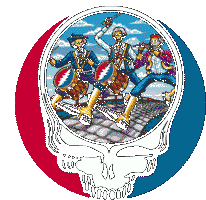'Dreadheads' takes a look at the high life

From the Aspen Times:
Attending shows by the Grateful Dead and like-minded bands, Steve Hurlburt was struck by the dreadheads, the mostly youngish clan of fans that formed a disproportionate percentage of the audience. Just what, he wondered, was the connection between the music and the dreads?"Dreaddie kids don't follow Phil Collins. They follow this music," said Hurlburt. "And why is that?"With a background in journalism and photojournalism, friends in the film business - and numerous concerts to catch - Hurlburt turned his inquiry into a film. Between May 2002 and the fall 2004, he traveled to concerts from Phish's It Festival in Maine to Dead shows at Red Rocks to concerts in Atlanta, his hometown and current residence. Hurlburt talked to the dreaddie kids - a term he uses for dreadlock types ages 15-35 - and to musicians, including the Dead's Bob Weir and Widespread Panic's John Bell, and to Noel Erskine, a professor at Atlanta's Emory University and a native of Jamaica, the primary source for the latest wave of dread culture."Dreadheads," Hurlburt's 77-minute documentary, gets to the bottom of the questions he had about the dreaddies. The film, which has shown at the Psychotronic Film Festival in Savannah, Ga., and at a conference on pop culture in Albuquerque, makes its valley debut this weekend. After a week of mad scrambling to coordinate the screenings with Jazz Aspen Snowmass' Labor Day Festival, Hurlburt has arranged for "Dreadheads" to be shown at the Cabaret Room in Snowmass Village's Silvertree Hotel today and Saturday, Sept. 2-3, at 1:30 and 3:30 p.m. each day."Why do the dreaddie kids separate themselves from straight society when they don't have to?" said Hurlburt. "It's not innate. They're not gay. They're not black. They choose to do it."One thing the dreaddie kids mention a lot is freedom - freedom from having to upkeep their hair, freedom from hair-care products. And they also talk about the freedom in the jam-band scene - the freedom to improvise, to go off."That is quite a ways from what the origins of dreadlocks are. Hurlburt's investigation revealed that dreads were worn historically by two separate castes of people: the priests and the warriors."That was interesting. On the one side, it was to connect with God. On the other, it was to look like a madman, like a warrior," he said. "But for these kids, it was neither spiritual or a warrior thing. It's an outsider statement, and to some degree, a connection with the ganja side of Rastafarianism. And it's also a style."Hurlburt says that "Dreadheads" also examines what dreaddies are not. "One of the first questions people ask is, 'Aren't these all upper-class trustafarians?'" - a term of derision for the well-off who wear dreads as an affectation - "who have all the money they need? I find that not to be true. They're from middle-classes, broken homes. So their family, their support community, is the other dreaddies."Another thing people ask is, 'Is there a religious reason, a Rasta connection?' And I found that not to be true 95 percent of the time." Hurlburt noted, however, that the popularity of Bob Marley, the late reggae king, has been the strongest inspiration to go dread over the past 30 years."Dreadheads" also puts a pin in the myth that the way to achieve dreadlocks is not to shampoo. He says shampooing is a must, but conditioner and combs are no-nos. The key is to not allow one mass knot to form, but to continually pull apart separate knots into dreads.The musical component to "Dreadheads" goes beyond the thematic link between dreads and jams. In addition to appearances by Widespread Panic's John Bell and Dave Schools, the Dead's Weir, and guitarist Jimmy Herring, the soundtrack features music by Schools' side project Slang, Sound Tribe Sector 9, Project Z and Lake Trout. The original soundtrack is by Spunhuny, a band that includes Hurlburt on guitar and vocals.Hurlburt has done some extracurricular studies on dread culture. When he made "Dreadheads," he had long, straight hair. Last year, he grew dreads, which he still sports."From my circle of friends, very few of whom have dreads, they don't hesitate to suggest that I might want to cut it all off and start over," he said. "From people I don't know, I get looks. But I've never been singled out for maltreatment, and a lot of the kids have."Stewart Oksenhorn's e-mail address is stewart@aspentimes.com



0 Comments:
Post a Comment
<< Home